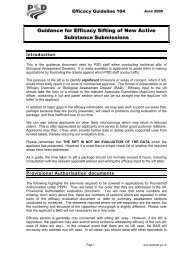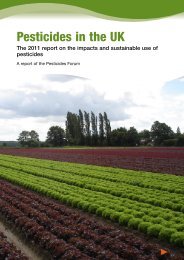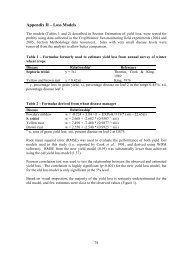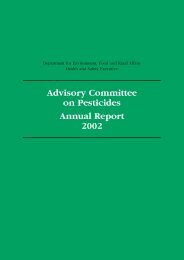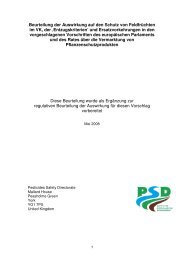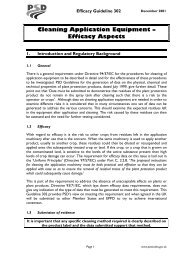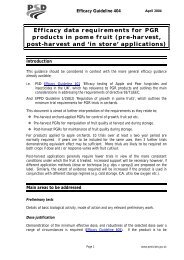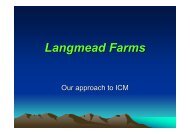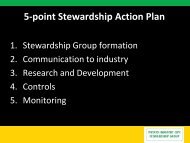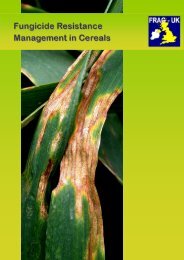Advisory Committee on Pesticides Annual Report 2001
ACP Annual Report 2001 - Pesticides Safety Directorate
ACP Annual Report 2001 - Pesticides Safety Directorate
You also want an ePaper? Increase the reach of your titles
YUMPU automatically turns print PDFs into web optimized ePapers that Google loves.
<str<strong>on</strong>g>Advisory</str<strong>on</strong>g> <str<strong>on</strong>g>Committee</str<strong>on</strong>g> <strong>on</strong> <strong>Pesticides</strong> <strong>Annual</strong> <strong>Report</strong> <strong>2001</strong><br />
Acceptable data were available <strong>on</strong> the nature and magnitude of residues that<br />
would result in wheat when sulfosulfur<strong>on</strong> was used in accordance with the<br />
principles of Good Agricultural Practice. Estimates of c<strong>on</strong>sumer dietary intakes<br />
were significantly lower than the ADI.<br />
The risks to birds, terrestrial vertebrates, bees, earthworms and soil microorganisms<br />
from the proposed use of sulfosulfur<strong>on</strong> and from metabolites<br />
formed in the envir<strong>on</strong>ment were c<strong>on</strong>sidered acceptable. The potential risk<br />
to aquatic higher plants is high. On the basis of its toxicity to Lemna gibba,<br />
‘M<strong>on</strong>itor’ is classified as extremely dangerous to aquatic organisms. A five<br />
metre no spray z<strong>on</strong>e was c<strong>on</strong>sidered sufficient to manage the risk to aquatic<br />
higher plants from spray drift.<br />
28<br />
Sulfosulfur<strong>on</strong> might reach surface waters via drainflow. To address the<br />
potential risk to aquatic higher plants posed by parent compound as a<br />
c<strong>on</strong>sequence of drainflow, the applicant submitted modelling data for a<br />
number of scenarios covering five soil types and three climate types and<br />
using weather data for 30 years. These data indicated that <strong>on</strong>ly in a very few<br />
excepti<strong>on</strong>al scenarios would the c<strong>on</strong>centrati<strong>on</strong> of sulfosulfur<strong>on</strong> in surface<br />
water pose a risk to higher aquatic plants.<br />
The data <strong>on</strong> n<strong>on</strong>-target plants provided indicated that there is a potential risk to<br />
plants close to the treated area. It was therefore recommended that the product<br />
label should carry a str<strong>on</strong>g warning to avoid drift <strong>on</strong>to n<strong>on</strong>-target plants.<br />
The <str<strong>on</strong>g>Committee</str<strong>on</strong>g> recommended provisi<strong>on</strong>al approval for ‘M<strong>on</strong>itor’ for use <strong>on</strong><br />
winter wheat pending the Commissi<strong>on</strong> decisi<strong>on</strong> <strong>on</strong> inclusi<strong>on</strong> of sulfosulfur<strong>on</strong><br />
in Annex I of Council Directive 91/414/EEC.<br />
Zoxamide<br />
Zoxamide (Development code RH-7281) is the ISO proposed name for a new<br />
fungicide intended to c<strong>on</strong>trol late blight <strong>on</strong> potato and downy mildew <strong>on</strong><br />
grape. The <str<strong>on</strong>g>Committee</str<strong>on</strong>g> c<strong>on</strong>sidered an applicati<strong>on</strong> for approval of RH-7281<br />
mancozeb, a water dispersible granule c<strong>on</strong>taining both zoxamide and<br />
mancozeb, a fungicidally active substance used in a number of products that<br />
are already approved for use in the UK. It was noted that the use of the two<br />
active substances in combinati<strong>on</strong> provided improved disease c<strong>on</strong>trol over that<br />
achieved with mancozeb al<strong>on</strong>e and allowed for a reducti<strong>on</strong> in the rate of use<br />
for mancozeb. Zoxamide is also being c<strong>on</strong>sidered for inclusi<strong>on</strong> in Annex I of<br />
Directive 91/414/EEC with the UK acting as Rapporteur Member State.




